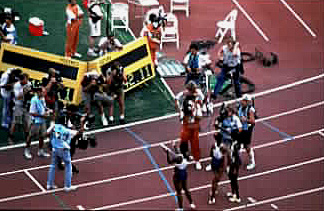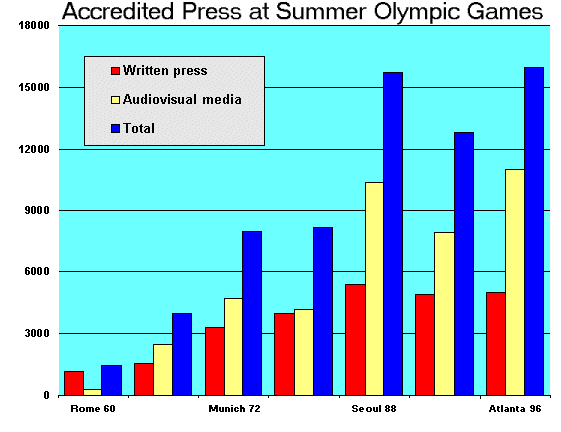![]()
From humble beginnings in terms of press coverage, the Olympic
Games have today become the 'Greatest Show on Earth'. Only eleven
journalists covered the first modern Olympics, held in 1894 in
Athens. Today, the contingent of media personnel is the largest
single group to converge at the Games, easily dwarfing the other
services, and even outnumbering the athletes themselves. The
enormous, almost universal appeal of the event and the
concomitant potential for generating advertising revenue,
combined with the Olympics' ability to provide wonderfully
striking images - both moving and still - has resulted in
tremendous growth in media attention in recent years.
 For the Barcelona Olympics,
147 television and radio stations were accredited to provide
coverage of the Games. They were housed in a facility
second-to-none. The Main Press Centre occupied over 51,000
square metres, an increase of two-and-a-half times over the space
allocated at the Los Angeles Olympics held only eight years
earlier. The facility was operational 24 hours a day,
accommodating the needs of the press from all around the world,
who were working to deadlines in all time zones. It contained
several walls of giant modular screens, capable of displaying a
single large image or multiple images from a range of Olympic
events and locations. Journalists could take advantage of 125
production areas, a video library containing the televized
production of the Games, monitors linked to every sporting event,
a telecommunications centre, banks of networked computers
providing instantaneous sports results, press rooms accommodating
up to 1,200 people and providing simultaneous translation
services, and telephone lines specially prepared to accept
high-definition electronic transmission of photos, among other
special facilities.
For the Barcelona Olympics,
147 television and radio stations were accredited to provide
coverage of the Games. They were housed in a facility
second-to-none. The Main Press Centre occupied over 51,000
square metres, an increase of two-and-a-half times over the space
allocated at the Los Angeles Olympics held only eight years
earlier. The facility was operational 24 hours a day,
accommodating the needs of the press from all around the world,
who were working to deadlines in all time zones. It contained
several walls of giant modular screens, capable of displaying a
single large image or multiple images from a range of Olympic
events and locations. Journalists could take advantage of 125
production areas, a video library containing the televized
production of the Games, monitors linked to every sporting event,
a telecommunications centre, banks of networked computers
providing instantaneous sports results, press rooms accommodating
up to 1,200 people and providing simultaneous translation
services, and telephone lines specially prepared to accept
high-definition electronic transmission of photos, among other
special facilities.
 Adjacent to the Main Press
Centre was a specialized facility for radio and television
representatives. The International Broadcast Centre
occupied over 45,000 square metres, and for the duration of the
Games was home to the host broadcaster, RTO92, and the other
rights-holding broadcasters. The centre was a huge conglomeration
of television and radio production suites, editing and
post-production facilities, commentary booths, telecommunications
equipment rooms, and meeting rooms and facilities to service
around 8,000 people. Because of the nature of the work performed
there, the building was soundproofed and climate controlled.
Adjacent to the Main Press
Centre was a specialized facility for radio and television
representatives. The International Broadcast Centre
occupied over 45,000 square metres, and for the duration of the
Games was home to the host broadcaster, RTO92, and the other
rights-holding broadcasters. The centre was a huge conglomeration
of television and radio production suites, editing and
post-production facilities, commentary booths, telecommunications
equipment rooms, and meeting rooms and facilities to service
around 8,000 people. Because of the nature of the work performed
there, the building was soundproofed and climate controlled.
The growing number of media personnel reflects not only the
seemingly continuous growth in interest from the press, and the
growth of the media industry worldwide, but the growing
sophistication of the equipment used to bring the games to people
all over the world.